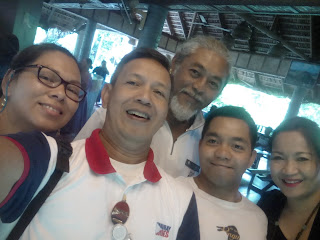 |
| Pawikan Festival participants |
Now that it's Christmas, I get the much needed relaxation time I've been longing for in weeks. And so, it's apropos to catch up on my much delayed blog entries. I have tried to post as regularly as I can but the hectic pace of my work just won't afford me the few precious minutes to compose my blog stories. So permit me to work my way backwards and try to recall the assignments I have taken on.
 |
| opening ceremonies by the governor of Bataan |
PAWIKAN FESTIVAL
 |
| In performance |
I was honored to have been invited to a seminar/workshop on production design conducted by the Bataan Tourism office last year. The training module was organized by Nilo San Agustin of the Department of Tourism. Invited as SME's (subject matter experts) were: Renato del Rosario for Music, Armando Sta. Ana for Stage Direction, Nonoy Froilan for Choreography and myself for Production Design.
 |
| Filipiniana costume |
The objective of the workshop was for us to impart our knowledge to representatives of thirteen Bataan municipalities who all participate in the yearly Pawikan Festival. Pawikan is a Filipino term for turtle. Olive Riddley turtles to be exact! There was a whole gamut of activities lined up for the festival. Included in the roster of events were beach volley, on the spot painting competition, installation art from recycled materials, the street dancing competition and the obligatory releasing of turtle hatchlings into the west Philippine sea.
 |
| Pawikans in the wings |
The long stretch of beach in Morong, Bataan is a nesting ground for turtles. The Municipality of Morong has undertaken the gargantuan task of protecting these turtles from poachers and has built a festival around it. This is in line with their advocacy of educating the majority in the aspect of environmental awareness and protectionism for endangered sea turtles.
 |
| billowing skirts |
The Pawikan Conservation Facility in Morong gathers and protects turtle eggs laid on the shoreline and incubates these turtle eggs until they are mature enough for eventual release into the wild. At times, they are also able to rescue turtles caught in fish nets and stranded on the shore. These mature turtles, on the other hand are nursed back to health before they are released into the deep blue.
 |
| men's ensemble |
Unfortunately, when we were invited for the seminar last year, the festival had just ended. We were not able to witness how the street dancing competition was conducted. This year, having been invited as judges for the street dancing competition, I was quite happy to see that our inputs on production design and choreography were incorporated into the dance presentations. the beach front came alive with contingents from the municipalities of Bataan.
 |
| little hatchlings |
Each contingent had forty participants outfitted as dancers, plus a few more who were in the production team as set riggers and production assistants. It was a day long event highlighting the importance of saving the ecological balance, protecting the endangered sea turtle and of course, promoting Bataan as a natural sanctuary of riddley turtles, whose numbers have been steadily dwindling over the years until Morong's authority took action.
 |
| impressive backdrop |
The poachers were kept at bay, the riddley turtles returned and are starting to multiply again, the local residents have increased their means of livelihood and Bataan's reputation and tourism draw has been enhanced. Judging by the pictures, it would be safe to say that everyone had a grand time. I hope to be back again next year to see how the Pawikan Festival continues to evolve.
 |
| Turtles galore |



















































